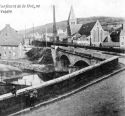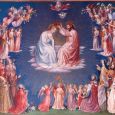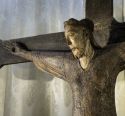Church | 1893-1899 | Neogothic | Catholic Church



Map
Opening hours
01 January - 31 December
Mon -
Tue -
Wed -
Thu -
Fri -
Sat -
Sun 10.00 - 17.00
A glass window, open every day, provides a view of some of the church's outstanding features.
Church closed due to flooding in July 2021.
Guided tour
On request : +32 87 67 57 41
Religious offices
Description
Situated in the main street of the commune, the church’s exterior is unobtrusive and little noticed.
The interior on the other hand holds a surprise. It is one of the most remarkable Neo-Gothic buildings in the country. The interior appointments are of a fine artistic richness. This is due to the initiative of Abbot Balau, vicar of Pepinster in 1891 who attracted the best artists and artisans of the period notably from Liege, Louvain and Gent. The result is impressive.
Firstly there is the vaulted ochre coloured ceiling, and then on the walls are paintings of religious scenes. It has been calculated that the church contains nearly 600 painted or sculpted personalities. Especially successful is the coronation of the Virgin above the right hand altar. There are many beautiful stained glass windows. The Stations of the Cross composed of 18 large tapestries based on the old tapestries of Brussels are astonishing. These hang on the walls of the large nave above the columns where, unfortunately, they are not easily visible. Also worth seeing is the altar in the choir of Tournai marble and a polychrome wooden statue of the Virgin.
Photos
Remarkable elements
The Coronation of the Virgin Mary
A large mural painting above the entrance to the Chapel of the Virgin Mary is particularly noteworthy: "The Coronation of the Virgin Mary". The Virgin and Christ are surrounded by a people of witnesses, all identified, including Saint Lambert, Saint Antoine-Ermite, Saint Francis of Assisi, Saint Remacle, Saint Vincent de Paul, Saint Barbara... The painting was done by Adolphe Tassin, a student of Jules Helbig around 1909.
The vault
A significant part of the atmosphere of the interior complex comes from the original "Francart" vaulting system. It is almost innovative in religious architecture, and consists of a metal structure on which terracotta shingles rest. They form an original background of natural red ochre colour on which stand out the paintings made by Adolphe Tassin.
The 3 large stained glass windows
Les vitraux qui ornent les fenêtres ont tous été réalisés par les ateliers Gustave Ladon à Gand. Le grand vitrail occidental, au fond de la nef, retrace l’histoire ecclésiastique de nos régions depuis leurs origines. Le vitrail de l’Ancien Testament (bras sud du transept) est un des vitraux les plus réussis de l’église de Pepinster. Le vitrail de l’Église (bras nord du transept) reproduit des scènes de l’Ancien Testament confrontées à des récits tirés du Nouveau Testament. Les apôtres et les évangélistes y sont aussi représentés.The triumphal cross
The entrance to the choir is marked by a majestic triumphal cross due to the Van Uytvanck and Goffaerts workshops for the statuary and Oscar Algoet for the polychrome. This one is placed on a beam and is surrounded by four statues: the Virgin, Saint John, the personalizations of the new (the Church) and the old (the synagogue) Alliances.
The main altar
The main altar is also a work of the Van Uytvanck and Goffaerts workshops for sculpture and of Algoet for polychromy. Dating from 1896, it is made of black Tournai marble in its lower part. The altar table is topped by a polychrome wooden predella decorated with 12 medallions in bas-relief representing the apostles.
The altarpiece frames the niche reserved for the "tabernacle" set with cabochons. It is composed of 2 scenes in high relief: the Last Supper and the Multiplication of Breads. These are surrounded by 2 polychrome wooden shutters in bas-relief.
The tapestries forming the Way of the Cross
The walls of the main nave are covered by an exceptional Stations of the Cross composed of 18 carpets with vertical warp. They are made by the professional school of the Annunciates Sisters of Heverlee after the projects and patterns of the canon Armand Thierry based on the models of the carpets of Brussels from the 1500s to 1515, made by the master Jan van Room.
One could say that the carpets ensure a successful transition between the first and the second level. The use of the tapestry technique for a Stations of the Cross of such a size in a church is very rare: we do not know of any other example.Les tapisseries formant le chemin de croix
Nearby
Circuit
The Vesdre region in the 19th century - car

The Verviers Region at the time of the Industrial Revolution (car route) - Discover to what extent the wool industry has allowed the development of the villages around Verviers.



































